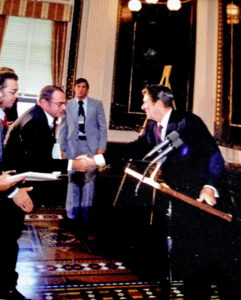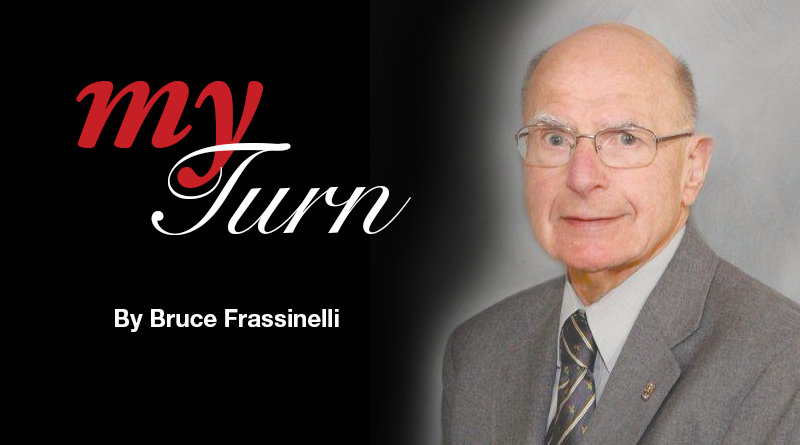Covering a White House News Conference
By Bruce Frassinelli
Email: bfrassinelli@ptd.net

The mailgram arrived 40 years ago, on July 2, 1981, signed by then-President Ronald Reagan.
“I would like to invite you to join me and other officials in my administration for a briefing and luncheon at the White House on Monday, Oct. 5. We will be discussing the economy and other domestic issues, as well as foreign policy.”
At the time, I was the managing editor of a newspaper in Pennsylvania for only three months. The president had survived an assassination attempt by John Hinckley outside of a Washington, D.C., hotel on March 30, just a little more than three months earlier.
Reagan was holding these periodic regional press conferences for editors of smaller papers and radio and television stations to bypass the giant newspapers, such as The New York Times and The Washington Post, major TV networks and major wire services such as The Associated Press. He said he wanted to get his message across to the American heartland through smaller media.
I called the White House Press Office and told an aide to sign me up. I’d have to undergo a security check, the aide told me. I gave my name, address and Social Security number. The aide told me she’d get back to me “if there were any problems.”
Since I didn’t hear anything, I concluded that the administration didn’t consider me a national security threat.
Mentioning the invitation in casual conversation with friends and colleagues, I received a spectrum of reaction. Some were reverently impressed; others suggested that I’d be lucky if the president even showed up.
I worried about that, too, especially since he had been seriously wounded in the assassination attempt. Naturally, I was looking forward to meeting him. It would be nice if I could get to ask him a question during the press conference, and it would really be great if I could shake hands and talk with him for a moment.
I began to wonder how I could involve our readers. Many of them probably would consider meeting any president a once-in-a-lifetime thrill, an opportunity few would ever experience. Reagan, especially, was very popular with the public.
I decided that in some small way I’d try to get the pulse of at least some readers, so on the Thursday and Friday before I left for Washington, I drove through our circulation area knocking on doors.
I asked more than 30 people what they would say to President Reagan if they could meet him and talk with him for a minute or two. During the weekend, I compiled a summary of their comments.
When I arrived at the southwest gate of the White House at 8:58 a.m. on Monday, Oct. 5, 1981, I was met by L.C. Jones, a 6-foot, 4-inch security guard. “May I see your ID please, sir?” Jones asked, unsmiling. I showed him my press pass. “Please open your briefcase,” Jones ordered.
He and another security guard rummaged through the papers, magazines and assorted junk I had in the briefcase. Jones couldn’t get the snap to shut. After fumbling with it for about 10 seconds, he looked at me pleadingly.
“I’ll do it,” I said, taking the cue. “Follow her,” Jones said, pointing to Karna Small, White House director of media relations and planning who took several of us into a wing of the White House and to another checkpoint.
“Step through here,” said a guard as he motioned us through a security portal.
“Bong!” went the alarm as I passed through.
“Take your glasses off, sir, and try again,” the guard said. I did as I was told.
“Bong!” went the alarm.
I reached into my jacket pocket and fished out my camera. “Maybe this?” I asked sheepishly, embarrassed that I had forgotten I had it there.
“That’s probably it,” the guard said. I passed through the portal again. This time, there was no bong.
The guard also checked my briefcase. Again, the snap would not close. “You have to know how to work it,” I laughed. The guard was not amused. Finally, the snap clicked shut.
At the entrance to the Treaty Room, where the briefing would be held, we were directed to stacks of a news release dated three days earlier.
“Oh, great,” I thought to myself. “This stuff is old. This day is going to be a bust.”
The Treaty Room was spectacular. The walls of the two-story room are embedded with marble panels. The balustraded balcony is inlaid with Mexican onyx. The lamps are supported by four-foot high Cupid-like figures.
Nearly all of the seats were taken, but I noticed an empty one in the front row. As I walked toward it, I saw a camera and bag on it and thought it had been reserved. Lucky break— it wasn’t. So I had a front-row seat no more than four feet from the lectern where the president would be speaking — assuming he showed up.
Karna Small briefed us, saying the president had a busy day. “Here it comes,” I thought, “the announcement that the president wouldn’t be here.”
“But he’ll be here for a few minutes at 9:30,” Small said. I mentally apologized for being a doubter.
A few minutes later, I heard a rustle of activity and heard people springing to their feet.
“Ladies and gentlemen, the President of the United States,” someone announced.
Reagan walked briskly to the lectern. Joined by Treasury Secretary Donald Regan and Budget Secretary David Stockman, Reagan looked in perfect health. He wore a dark blue suit, white shirt, and maroon and blue tie, with a white handkerchief protruding from his breast pocket. His black shoes were polished to a high gloss.
“Thank you very much and welcome,” the president said. “Believe me, it is a pleasure to welcome you to the White House. This is something that all of us in the administration have looked forward to, and you don’t need me to tell you the tremendous influence you have on public opinion.”
The president was in good spirits. Obviously enjoying himself, he interjected bits of humor among the somber news of the economy and soaring inflation, Social Security, defense and other major issues.
He gave a five-minute laundry list of what he and his administration had been doing in the last month. Then he looked up and smiled.
“Now I think that’s pretty good for a fellow who works only two or three hours a day,” Reagan joked. Lots of laughter. The reference was to some critics who said the president kept “country club” hours and didn’t do much work.
“I hope you will find your day here a useful and productive one, and I hope you will also relax and enjoy yourselves,” he said. “But don’t relax too much. As you know, my staff is rather reluctant about waking people up.”
That one brought down the house. It was a reference to the flap that had occurred following the shooting down of a Libyan jet two months earlier after it had fired on an American aircraft. Advisers decided not to wake the president to tell him about it until six hours after the incident.
The president said he would take a few questions.
I raised my hand. As I did, I heard this thundering rumble behind me and voices calling out “Mr. President! Mr. President.”
I flushed, embarrassed at my naivete. This was going to be done like the White House press corps does it: You spring to your feet, calling out “Mr. President,” and hope you catch his eye and outmaneuver the other questioners.
The idea was to anticipate when the president finished answering a question, then, you leap and call “Mr. President!” simultaneously.
For the first four questions, I had not gotten past a half-squat position on the way to my feet before he had acknowledged the next questioner.
“This obviously takes some practice,” I said to myself. I could feel little beads of sweat form on my brow, underscoring my frustration.
After the president had finished with the fifth questioner, I jumped up and with authority called “Mr. President!” but he pointed to someone in the back of the room. “At least I got to my feet that time,” I congratulated myself.
The president answered that question — on block grants. Then, I was on my feet again calling “Mr. President,” this time louder.
Being only four feet away from the president and slightly to his right when I got to my feet, I was practically on top of him. He turned slightly toward me, pointed at me, smiled and said, “Yes?”
I felt a hot light on my back — a television camera, I think. I saw eyes turning toward me. I had a sinking feeling. But, this was it, pal.
“Mr. President,” I started, feeling my voice quaver. “I hope I am not breaking with tradition by not asking a question.” He smiled and shrugged as if to say, “Well, I’ll let you know after we hear what this is all about.”
I continued: “After confirming my visit to this briefing, I decided to share the visit with some of the readers in our circulation area. I went knocking on doors in our area to ask readers what they might say to you if they had the opportunity to talk to you face-to-face.
“There were three things that came through most often, and I thought I’d like to share them with you.
“They are encouraged that there seems to be signs that there’s somebody in Washington who’s finally doing something about the economy. They’re not sure yet whether it’s going to work, but they’re pleased there is movement.
“They generally feel comfortable with your style, but there is still a healthy amount of skepticism about where your administration is going and where it might wind up.
“There is a lot of apprehension about how budget cuts might affect them personally or their loved ones. That concern was best expressed, I think, by a woman who asked me to tell you that in deciding how to make those cuts please think of us as a family, and make the decisions as a loving father would.”
The president smiled, obviously touched by the comment.
“And,” I continued, “everyone asked me to wish you the very best in what has to be a most difficult job.”
By this time, I was flushed and sweating profusely. I sighed with relief, glad that it was over and hoping I hadn’t made a fool of myself.
“Well, thank you very much,” President Reagan said, talking directly to me. “As for that lady, I would like to fulfill her request, and we are trying to do it. We are trying to remove government from the private sector. When you stop to think that today the biggest single cost item in the average American family budget is government, well, I don’t think it was intended to be like that.”
The president took several more questions, then said he had to leave. We stood. He took a step toward me and extended his hand.
“Thanks for bringing me that message from your people,” he said, looking deeply into my eyes. “Thank you, Mr. President, for the opportunity,” I said with a gulp.
In addition to me, he shook hands with several other journalists in the front row, turned, waved and left.
I could feel a lump in my throat as I relished a special moment in my life — one I will never forget.
Next, it was on to lunch, which was hosted by Vice President George H.W. Bush.

